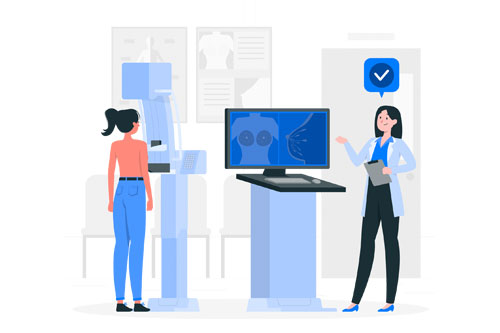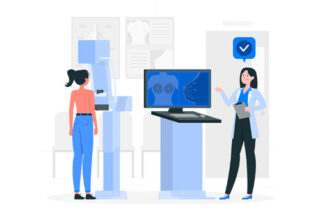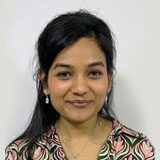Silent Threat: Why Younger Women Get Breast Cancer

Silent Threat: Why Younger Women Get Breast Cancer
Dr. Astha Shreyash Khemuka
India’s Leading Breast Imaging Expert
 This may surprise you.
This may surprise you.
In your busy schedule, where life moves at a relentless pace, a silent threat lurks beneath the surface that can unsettle your family and career.
Breast cancer can target younger women when you least expect it.
Sounds a bit unrealistic, right?
Let’s dive into why this happens and what we can do about it, without the medical jargon.
The not-so-great news:
Traditionally, we all think that breast cancer is more of a concern for older women. Don’t we?
While it’s true that breast cancer risk is often associated with women over 40, younger women are not immune. That’s why it’s crucial to understand your risk factors and make informed decisions about your health.
If you have high breast density, a family history of breast cancer, a personal history of previous breast lumps (including non-cancerous), early menstruation before the age of 12,[1] certain genetic mutations, etc., waiting until you’re 40 to begin routine annual mammograms might not be safe for you.
While the above risk factors are not in your control, you can avoid certain controllable factors that raise the risk of breast cancer. What are they?
In this blog, let’s better understand both non-controllable and controllable risks and explore actionable steps you can take to address them.
Breast density, a hidden risk factor you can’t ignore:
While many women have heard of breast density, few understand its implications. Breast density refers to the amount of fatty tissue versus glandular tissue in your breasts. Women with dense breasts have more glandular and connective tissue.
Your breasts may not feel different if they are dense. Also, breast density is not related to firmness or size. It can’t be felt either through a breast self-examination or by your doctor during a clinical breast exam. Only a radiologist looking at your mammogram can tell if you have a dense breast or not.[2]
High breast density is a well-established risk factor for breast cancer. Women with dense breasts are at a higher risk of developing the disease.[3]
The younger you are, the denser your breasts are:
Breast density tends to be higher in younger women, making it all the more important for those younger than 40 to be proactive about their breast health. Know your density today irrespective of your age, and consult your doctor to check if you need any extra protection.
Breast cancer in women with dense breasts was about 22% more than in women with non-dense breasts as measured by a Norwegian study that examined 3,07,015 digital screening records of over 1,00,000 women.[4]
Starting an annual mammography screening routine earlier than age 40 may benefit the women with dense breasts as found by another large US study of more than 5 million mammograms.[5]
Dense breasts used to pose another risk previously with older technology mammograms. It was hard for doctors to detect cancer hiding underneath dense tissue in some cases. But now the latest 3D mammography machines are designed to provide higher quality images with more comfort and improve breast cancer detection in dense breast tissue from multiple angles.[6]
Your family footprints can enhance your breast cancer risk:
You know that family history talk? Turns out, it’s not just about family gossip. Some families might have a history of breast cancer, which could make us more likely to get it. So, it’s not a bad idea to peek into the family tree and see if we should know anything.
If your mother, sister, or daughter (first-degree relatives); or multiple family members on either your mother’s or father’s side have had breast or ovarian cancer, then it will raise your risk of having breast cancer irrespective of your age.
Your personal history as a breast cancer indicator:
If you previously had breast lumps, breast disease (either cancer or non-cancerous), radiation therapy, certain genetic changes such as BRCA1 or 2, or had early mensuration before age 12, your risks are higher for breast cancer[7].
The factors you can control:
While the above three risk factors are out of your control, some aspects add up due to your lifestyle, which you can change with healthy choices or discipline.
An inactive lifestyle, alcohol consumption, having first pregnancy after age 30, and certain hormone replacement therapy are the controllable risk factors of breast cancer.[8]
Living in the fast lane can be thrilling, but it comes with its own set of challenges. Stress, crazy work hours, and not moving around enough – these things might be buddies with breast cancer. It’s time to take a pause, look at our daily choices, and think about how they might be affecting our health.
The Wonder Woman Way: Regular checkups!
Now, here’s the good news, ladies– you have a superhero move in your arsenal, i.e., regular screening mammograms. Mammograms can catch breast cancer early, way before it becomes life-threatening. So, if you carry any of the above risks, making sure you get a mammogram every year is like having a secret weapon against this sneaky visitor.
Mammography is the gold standard test for early breast cancer detection.[9] Breast cancer deaths are reduced by 30% to 50% with annual screening mammography performed on all qualified women.[10]
Mammography technology has made rapid progress in recent years to enable speedier and more comfortable mammograms at much lower radiation doses than ever before.
The latest 3D mammography machines in the digital mammography family are designed to deliver the fastest and the highest resolution mammograms, with more comfort, and at the lowest radiation dose within the allowable limits.
Take charge:
- If you’re a woman younger than 40 with a high-risk profile, it’s time to talk with your doctor about starting routine mammograms sooner, rather than later. Don’t let misconceptions about age or the notion that breast cancer only affects older women hold you back from ensuring your well-being.
- If you are above 30 years of age with no high-risk profile, remember, breast density is a crucial breast cancer risk factor. Since it tends to be higher in younger women. please find your breast density today with a routine mammogram. If you have dense breasts, it may be safer for you to subscribe to an annual screening plan now in consultation with your doctor.
- If you are 40 or above with neither dense breasts nor other high risks such as personal or family history, begin your annual screening mammography routine now because the vast majority of breast cancers occur due to unknown causes and factors in women above 40 years who are healthy otherwise. Remember, you can’t prevent breast cancer. Early detection is the best protection.
Hence, it’s never too early to start prioritizing your health for the sake of your family.
By arming yourself with knowledge and making informed choices about mammography, you’re empowering yourself to navigate your well-being with confidence and resilience.
Don’t wait. Take charge of your breast health today for a brighter and healthier tomorrow!

Dr. Astha Shreyash Khemuka
Consultant Radiologist
Khemuka X-Ray and Ultrasound Clinic, Dhantoli, Nagpur
- https://www.cdc.gov/cancer/breast/basic_info/risk_factors.htm accessed on 13 Jan 2024
- https://www.cancer.gov/types/breast/breast-changes/dense-breasts accessed 13 Jan 2024
- Boyd NF, Guo H, Martin LJ, et al. Mammographic Density and the Risk and Detection of Breast Cancer. New England Journal of Medicine. 2007;356(3):227-236. doi:10.1056/nejmoa062790
- Moshina N, Sebuødegård S, Lee CI, et al. Automated Volumetric Analysis of Mammographic Density in a Screening Setting: Worse Outcomes for Women with Dense Breasts. Radiology. 2018;288(2):343-352. doi:10.1148/radiol.2018172972
- Lee CS, Ashih H, Sengupta D, Sickles EA, Zuley M, Pisano E. Risk-Based Screening Mammography for Women Aged. Journal of the American College of Radiology. 2020;17(3):368-376. doi:10.1016/j.jacr.2019.08.033
- https://www.mayoclinic.org/tests-procedures/3d-mammogram/about/pac-20438708 accessed on 13 Jan 2024
- https://www.cdc.gov/cancer/breast/basic_info/risk_factors.htm
- https://www.cdc.gov/cancer/breast/basic_info/risk_factors.htm
- https://www.webmd.com/breast-cancer/features/mammography-still-gold-standard-for-breast-cancer Accessed on 23 Aug 2022.
- Feig S. Comparison of Costs and Benefits of Breast Cancer Screening with Mammography, Ultrasonography, and MRI. Obstetrics and Gynecology Clinics of North America. 2011;38(1):179-196. doi: 10.1016/j.ogc.2011.02.009
